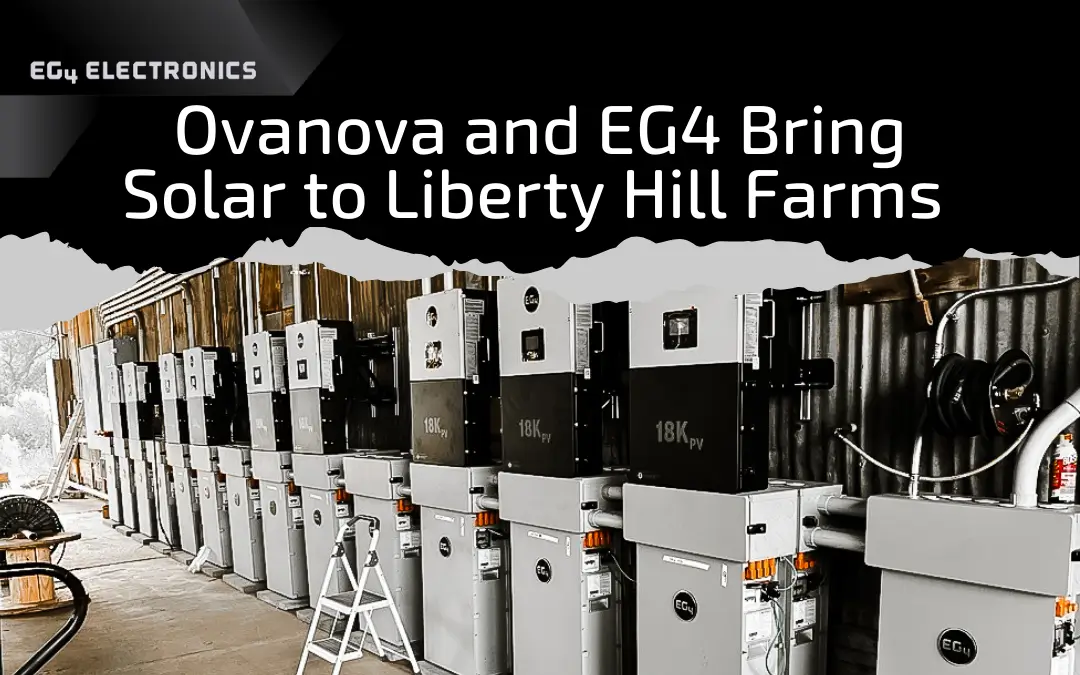Spearheaded by Ovanova, the solar installation at Liberty Hill Farms is the largest project using EG4 Electronics products in the United States to date. Across three sites at the farm, Ovanova has set up solar systems featuringEG4 18kPV inverters and EG4’s WallMount All Weather batteries. Their setup amounts to 204kW of continuous AC power output being fed by approximately 267kW of PV panels spread across the roof and 500kWh of storage.
Liberty Hill Farms, operated by the Dowdy family, has a rich history and a forward-looking vision. Traditionally known for row crops such as soybeans, the farm also houses a shop that was once a 100-year-old cotton gin. With the help of Ovanova and EG4 Electronics, it has become the hub for renewable energy on the farm.
Embracing Solar Energy while Preserving Farmland
But why choose to utilize the roof space of a former cotton gin as the primary site for this project? According to Chris Snodgrass, head of installation at Ovanova, the decision was rooted in a deep respect for the land and the values of the rural community. “People in the country really value their land,” Chris explains. “There’s a sense of pride in preserving farmland for its intended purpose: agriculture.” This sentiment is especially strong among farmers, who often view large-scale solar farms with a degree of skepticism. These installations can occupy vast expanses of prime farmland—land that the community believes should remain dedicated to cultivation and livestock.
As Chris points out, “It’s a win-win. We’re using space that isn’t going to do anything else, so the farmer doesn’t have to choose between generating electricity and preserving viable farmland.”
Overcoming Code and Layout Challenges
Every large-scale project comes with its own set of challenges, and the solar installation at Liberty Hill Farms was no exception. Retrofitting a 100-year-old cotton gin to house a modern solar array and energy storage system brought unique obstacles, particularly concerning code compliance and layout design.
One of the primary challenges was dealing with the existing electrical work that, while functional, was far from code compliant and potentially unsafe. “We had to address a lot of old work that wasn’t up to modern standards,” Chris shared. “This wasn’t just about safety; it was also about aligning everything with current codes, which can be a time-consuming process.”
Additionally, an unforeseen complication arose when the team observed the operation of a nearby pellet mill, which converts agricultural byproducts into pellets. The mill produced fine dust that could potentially interfere with the equipment. “We realized that one of our key components, a dry-type transformer, was installed right where this fine dust would settle,” Chris recounted. “This meant we had to rethink our entire design.”
The goal was not only to find an elegant solution that minimized space but also to protect the most sensitive components from environmental factors that could affect their performance and longevity. By carefully considering the unique operational aspects of the site, they were able to devise a layout that not only complied with safety codes but also protected the equipment from potential damage.
EG4’s Role in Project Design and Execution
One of the major challenges of the Liberty Hill Farms project was effectively planning the layout for the installation, given its scale. Standard configurations didn’t fit the needs of this project. Typically, each inverter and battery setup would require about eight feet of wall space. With the number of components involved, this would have led to an impractically large installation. With so many inverters and batteries to mount, managing space became crucial. “We needed to figure out how to arrange all these components on the wall efficiently,” Chris from Ovanova explained.
After extensive planning, they devised what they believed was the optimal layout. Recognizing the constraints of the project, EG4 developed a custom bracket system that allowed inverters to be mounted off the wall. “Instead of being limited by wall space, we can now stack these components two or three deep,” Chris explained. This solution not only adhered to electrical code requirements but also ensured a mechanically sound setup that utilized the available space efficiently.
EG4 Tech Enhances Performance and Efficiency
The integration of EG4 inverters and batteries at Liberty Hill Farms has significantly boosted performance and efficiency. The use of hybrid inverters plays a key role, optimizing stored energy and reducing costs by strategically using battery power during peak periods, which is especially beneficial in tiered pricing systems.
EG4 inverters are also well-suited to Liberty Hill Farms’ three-phase delta electrical system, offering flexibility and efficiency with their three-phase output and DC-coupled architecture which reduces conversion losses.
The seamless interaction between EG4 inverters and batteries ensures reliable performance, eliminating the issues often seen with mixed-brand systems. This reliability is crucial for projects with critical power needs.
Future Use of EG4 Products by Ovanova
Ovanova is leveraging EG4 products in a variety of impactful projects, showcasing the versatility and effectiveness of our energy solutions. One notable project involves a grocery store in the panhandle of Florida. This installation presents a unique set of requirements due to the store’s operational demands, including constant use of refrigeration units. To meet these needs, the project utilizes EG4 inverters that can handle 208V three-phase systems, providing a robust solution for the store’s energy consumption.
Ovanova is also developing a modular energy solution using EG4 products. This project involves a 40-foot shipping container which will be fitted with EG4 inverters and batteries. The container will serve as a versatile energy shed, designed to address the space constraints often encountered in commercial installations. This approach allows for additional components to be added outside the main container if needed, optimizing space utilization.




